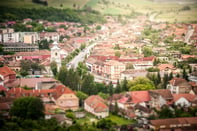Published on
Strengthening the College through Relationships with Local High Schools

The following interview is with Michelle Wood, the Director of Continuing Education at Vernon College. Wood headed up a program to link Vernon College with local area high schools through the Continuing Education division. In this interview, Wood discusses a few of the biggest challenges that had to be overcome in order to get the program off the ground, what the value of the program is to students, and how the relationship benefits the college and the continuing education unit.
1. How does the partnership between Vernon College Continuing Education and the local high school district work?
[The school districts] wanted to have more students leave their high schools with career skills when they get out of school. So what we’ve done is take some of the programs that they were interested in and put them into their school curriculum, so students not only receive high school credit, but they also are receiving valuable certifications and skills and even college credit before they leave.
So the partnership really fits perfectly into what we do and what they do, meshing the two. We’ve got a couple of different programs that we’ve shown success with. Our most viable program is our health careers program. It’s a three-year program and basically Vernon College hires a qualified instructor—someone that meets the state curriculum qualifications in order to train the certifications of the student—and we place them at the high school at… the high school’s convenience. We’re not trying to mesh the college schedule with the high school schedule. They’re placed inside the high school as a full-time instructor but they’re employed by Vernon College and we supply all the curriculum and the school provides the supplies, the students and anything the instructor would need for support.
The program is three years… it incorporates our sophomores, juniors and seniors. The first year is really an intro—we don’t count that program for funding because a lot of those students aren’t 16 which is something you can’t do—and it doesn’t really fall into the workforce education classes. We put it in there because it’s a good weeder course… it gives us an opportunity to see which students are really interested in healthcare, which ones are serious, which ones are discipline problems and then really weed them down for the next year. …
That second year, juniors will receive their certified nurse aid certification, before they graduate, and will also receive their CPR for healthcare providers, so they can go to work in our area and nurse aids start off at about $10.50 an hour. …
The last year, the senior year, if students make it through their first and second year, they are able to take four of the LVN [Licensed Vocational Nurse] articulated classes that would transfer into Vernon College’s LVN program if they got accepted. … They could potentially walk into our LVN program with five semester credit hours, and the students didn’t pay anything.
2. What are the benefits for the college?
When we hire an instructor we charge the school a little bit more than what their salary is… we count that as a tuition because we don’t charge students for typical tuition that we would have charged for LVN classes. … The schools do get charged a fee, and it’s a set fee—we don’t discriminate—it doesn’t matter if a high school has five students enrolled in a class or 30 students enrolled in a class, it’s still the same set percentage that we charge.
We also register those students for continuing ed, and now we have a continuing education transcript and a record of those students. So, for the college’s benefit, we now have kind of a feeder, and not only are they certified nurse aids, but they’re potentials for the LVN program, they’re potentials for the pharmacy program, they’re potentials for everything because they’re now very familiar with Vernon College. They’ve known us through their entire high school because our employees are actually Vernon College employees so it gives that natural progression.
Even if they don’t come to us for healthcare, we’re already certifying them in the workplace and we’re their first thought when they want to go to college.
3. Do the credits students earn count at any other colleges, or just Vernon?
The only credit that would count at another college is the certification of the CNA. The four semester credit hours for the LVN right now is just with Vernon College. Other colleges can look at it and see if they would prefer to accept it, but right now it’s only with Vernon College so they have to be accepted into our LVN program in order to claim those credits.
4. What kinds of registration challenges does bringing in high school students create for the college?
With continuing education registration forms, they’re pretty simple. They’re one-page forms, however we have to set up all our classes in the system. With our CNA, with the LVN, it means that we’re doing multiple registrations or multiple forms every couple of months because of our hour requirement and that kind of thing. That does pose a paperwork problem. Most instructors are interested in teaching but paperwork; getting it back is kind of a pain. We have a lot of help at the school with making sure we do have student socials, with making sure that we can get them in the system.
The only other scheduling and registration problem is the CNA year is a double-block period, which means that instead of it being one 45-minute period (which is the typical high-school period of the day), that second year for juniors is a double-block which means 90 minutes. Some of our students just don’t have that much time in their schedule; some of your best students don’t have two periods they can use for this program, whether they play sports. Scheduling it during the day is a hard thing. We can’t schedule those classes first thing in the morning because it rules out our band students, and it can’t be last thing in the afternoon because it rules out your athletic students. Playing that scheduling game is sometimes a challenge but most of the schools work it out and we try to figure out the best way for the students that are interested.
5. Has this program impacted the way the continuing education unit works with the rest of the college?
By doing this and building in feeders from high schools it’s really allowed continuing education to be more of a central role at the college. … Every time they have a high school that is interested in something related to us, if we are looking for feeders… we already have a built-in system at the high schools.
Our dual-credit people have the relationships and our recruiting always had relationships, but because we have people in the schools and we’re going and supervising and we’re interacting with them on a regular basis, it really provides continuing education with the face. We’re also able to stream our other programs into the high school. Where before you may not have an audience with a counselor to talk about…the programs that we offer in continuing education, we now have that audience. It’s really helped us become, instead of just continuing education, it’s now, “Oh! Well continuing education does this.” It’s worked not only for the high schools, but for the rest of the college.
6. Is there anything you’d like to add about the advantages Vernon College’s continuing education unit has brought to the college through this high school link program?
Having high school partnerships is great. It’s something where you want to make sure the high schools understand the return on investment. We really leave it up to the high schools where we give them the information and then letting them really see if it’s right for them. We don’t push anybody into it. Some of our programs have worked really well, other programs—such as the culinary arts program we just started is a phenomenal thing as well—you can think outside the box and we encourage schools and the continuing education department to do that; find what you do well and try to help high school students either feed into it or re-arrange their curriculums so that students are not only walking away with a home economics credit, but also walking away with a first aid certification and a skill that they can go out and get a job.
Author Perspective: Administrator



